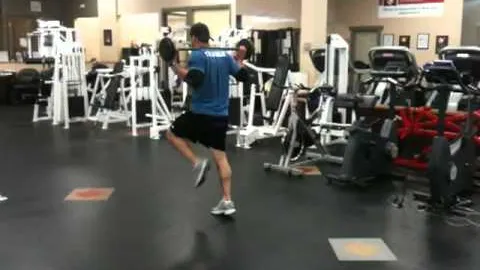
Are you looking to intensify your leg workouts? If so, consider incorporating the Barbell Walking Double Lunge exercise into your routine. This compound exercise targets multiple major muscle groups in your legs, enhancing both strength and stability. In this article, we will delve into the benefits of this exercise, provide step-by-step instructions on how to do it properly, and offer some variations to keep your workouts challenging and exciting.
Strengthens Leg Muscles - The Barbell Walking Double Lunge primarily targets the quadriceps, hamstrings, glutes, and calves. By engaging these muscles simultaneously, you can effectively build strength and develop more defined leg muscles.
Improves Stability - This exercise requires balance and coordination as you engage multiple muscle groups. By repeatedly performing the Barbell Walking Double Lunge, you strengthen your stabilizer muscles, which can enhance your overall balance and stability.
Increases Functional Strength - The functional strength gained from this exercise can benefit everyday activities such as walking, climbing stairs, or even lifting heavy objects off the ground. By engaging multiple muscle groups simultaneously, you are challenging your body in a way that mimics real-life movements.
Burns Calories - Due to the high-intensity nature of the exercise, the Barbell Walking Double Lunge can help you burn calories and contribute to weight loss. As it engages large muscle groups, it can also provide an effective cardiovascular workout.
Now that we have discussed the benefits, let's move on to the proper technique for performing the Barbell Walking Double Lunge exercise.
Equipment Needed: To perform this exercise, you will need a barbell and weights appropriate to your fitness level. Start with a weight that challenges you but allows you to maintain proper form.
Setup: Begin by standing with your feet shoulder-width apart, holding the barbell across your upper back with both hands in an overhand grip. Ensure that your core is engaged and your chest is lifted.
Step 1: Take a large step forward with your right foot, ensuring that your knee is aligned with your ankle. Lower your body into a lunge position, with your right thigh parallel to the floor. Keep your back straight and your core engaged throughout the movement.
Step 2: Push through your right foot, bringing your left foot forward and stepping into a lunge position with your left leg. Again, ensure that your knee is aligned with your ankle and your back is straight.
Step 3: Continue alternating between lunging forward with your right and left legs, maintaining proper form throughout. Aim for a smooth, controlled movement, ensuring that your knees do not extend past your toes.
Number of Reps and Sets: Start with 10-12 reps per leg and gradually increase the number as you progress. Aim for 3-4 sets, resting for 60-90 seconds in between sets.
To keep your workouts challenging and prevent plateaus, here are two variations of the Barbell Walking Double Lunge exercise:
Weighted Vest: Add an extra challenge by wearing a weighted vest while performing this exercise. The added weight will increase the intensity and further strengthen your leg muscles.
Reverse Barbell Walking Double Lunge: Instead of lunging forward with each step, take a step backward into a lunge position. This variation places additional emphasis on different muscle fibers, providing a well-rounded leg workout.
Warm-up: Prior to performing the Barbell Walking Double Lunge, it is essential to warm up your muscles with dynamic stretches and some light cardio exercises. This helps to increase blood flow and reduce the risk of injury.
Proper Form: Pay close attention to your form throughout the exercise. Keep your back straight, your core engaged, and ensure that your knees are in alignment with your ankles. Avoid leaning forward or letting your knees extend past your toes, as this can lead to knee strain or injury.
Start with Light Weights: If you are new to this exercise, start with lighter weights until you feel comfortable with the movement. Focus on maintaining proper form and gradually increase the weight as your strength improves.
In conclusion, the Barbell Walking Double Lunge exercise is a highly effective compound exercise that targets multiple major muscle groups in your legs. By incorporating this exercise into your leg workouts, you can enhance your leg strength, stability, and overall functional strength. Remember to perform the exercise with proper form, consider variations to challenge yourself, and always prioritize your safety by warming up properly and using appropriate weights. Incorporate the Barbell Walking Double Lunge into your routine and take your leg workouts to the next level.
If you're looking for a gym, fitness club or yoga studio, you've come to the right place.
You can find information about gyms in your area. Browse catalog of gyms and find gyms with classes which are you looking for.
On gym page you can find simple information like address, phone or website. You can find list of available classes. You can check availability of personal training or small group classes. On place page you can also see information about open hours.
You can find gyms near you with amenities, courts, studios and equipments.
Use our map to find gym at your city or district.
In Gym Navigator you can find list of exercises with movies for many body parts.
You can browse exercises catalog and find exercises the best of you.
You can also find exercises grouped into workout plans, which you can use to improve you body. Each routine show you exercises one by one and give you possibility to count you progress and count down rest time.